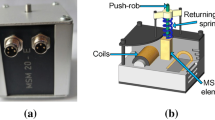Abstract
The present paper intended to identify the locations of piecewise linearly connected shape of a carrying current wire and its current magnitude based on data of three-axis magnetic sensor array mounted either on a surface or inside a volume. At first, we tested a few classical numerical computation methods and the least square method. The results indicated that these methods were incommensurate for this application. Then, we applied a locally linear neuro-fuzzy (LLNF) model with tree learning for modelling and identification of a linear piece of current. Based on sensor array locations; we proposed nine scenarios, a few of which include superficial array, volumetric array and a mix of superficial and volumetric arrays. For each sensor array model, a neuro-fuzzy structure identification based on the mean square criterion was carried out to select the best number of locally linear models. We found that LLNF model with volumetric and mix sensor array identified the position coordination and magnitude of a linearly shaped current very well. Finally, we applied one of the best arrays and locally linear modelling to solve this magnetic field inverse problem for piecewise linearly connected shapes of current. Our method for solving this inverse problem proved successful.






















Similar content being viewed by others
References
European Fusion Development Agreement (EFDA) website. http://www.efda.org
Ariola M, Pironti A (2008) Magnetic control of Tokamak plasmas. Springer, London
Tam E, Levchenko I, Li J, Shashurin A, Murphy AB, Keidar M, Ostrikov K (2011) Graphene and carbon nanotubes from arc plasmas: experiment and plasma modeling. IEEE Trans Plasma Sci 39(11):2798–2799
Xue E, Zhang X, Luo J, Yu L (2015) Plasma shape identification and fitting on the basis of image processing on Tokamak. J Fusion Energy 34:1348–1355
Mazon D, Blum J, Boulbe C et al (2009) Real-time identification of the current density profile in the JET Tokamak: method and validation. In: Joint 48th IEEE conference on decision and control and 28th Chinese control conference Shanghai, China
Thiébault B, Ruard BJ, Souquet P, Forest J, Matéo-Vélez J-C, Sarrailh P (2015) SPIS 5.1: an innovative approach for spacecraft plasma modeling. IEEE Nucl Plasma Sci Soc 43(9):2782–2788
De Tommasi G, Tala T, Ariola M, Crisanti F, Piront A (2005) Identification of a dynamic model of plasma current density profiles. In: 32nd EPS conference on plasma physics, ECA, Tarragona
Pironti A, Amato F (1995) On-line plasma shape identification for use in control systems. In: Proceedings of the 4th IEEE conference on control applications, Albany, NY
Hasegawa M, Nakamura K, Tokunaga K, Tokunaga K et al (2012) A plasma shape identification with magnetic analysis for the real-time control on QUEST. IEEJ Trans Fundam Mater 132(7):477–484
Jhang H, Kessel C, Pomphrey N, Kim J-Y (2001) Simulation studies of plasma shape identification and control in Korea superconducting Tokamak advanced research. Fusion Eng Des 54:117–134
Gerkšič S, Pregelj B, Perne M, Knap M, Tommasi GD, Ariola M, Pironti A (2016) Plasma current and shape control for ITER using fast online MPC. In: Real time conference (RT), IEEE-NPSS
Xiaolong L, Nakamura K, Yoshisue T et al (2013) Hinf loop shaping control for plasma vertical position instability on QUEST. Plasma Sci Technol 15(3):295–299
Gerkšič S, Tommasi GD (2016) ITER plasma current and shape control using MPC. In: IEEE conference on control applications (CCA)
Ambrosino G, Celentano G, Garofalo F, Glielmo L (1992) On-line plasma shape identification via magnetic measurements. IEEE Trans Magn 28(2):1601–1604
Kurihara K (1993) Tokamak plasma shape identification on the basis of boundary integral equations. Nucl Fusion 33(3):399–412
Blanken TC, Felici F, Baar MR, Heemels W (2015) Modeling, observer design and robust control of the particle density profile in tokamak plasmas. In: 54th IEEE conference on decision and control (CDC), Osaka
Mohamed SB, Boussaid B, Abdelkrim N, Tahri C (2015) LS/IV parametric identification for continuous and delay chemical reactor. In: 4th international conference on systems and control. IEEE
Li P, Fu L (2013) The research survey of system identification method. In: Fifth international conference on intelligent human-machine systems and cybernetics. IEEE
Nelles O (2001) Nonlinear system identification. Springer, Berlin
Nelles O (1999) Nonlinear system identification with local linear neuro-fuzzy models, Ph.D. thesis, Aachen, Germany, TU Darmstadt, Shaker Verlag
Sharifi J, Araabi BN, Lucas C (2006) Multi-step prediction of DST index using singular spectrum analysis and locally linear neurofuzzy modeling. Earth Planets Space Earth Planets Space 58:331–341
Sharifie J, Lucas C, Araabi BN (2006) Locally linear neurofuzzy modeling and prediction of geomagnetic storms based on solar wind conditions. Space Weather 4:1–12
Isermann R, Munchhof M (2011) Identification of dynamic systems: an introduction with applications. Springer, Berlin
Author information
Authors and Affiliations
Corresponding author
Rights and permissions
About this article
Cite this article
Sharifi, J., Seraj, N. Neuro-fuzzy modeling and solution of magnetic field inverse problem. Int. J. Dynam. Control 8, 690–705 (2020). https://doi.org/10.1007/s40435-019-00552-7
Received:
Revised:
Accepted:
Published:
Issue Date:
DOI: https://doi.org/10.1007/s40435-019-00552-7




